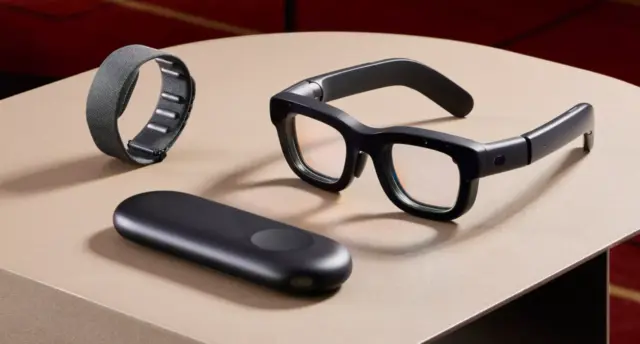
Leaked renders and detailed information indicate Meta is preparing to launch a new, high-end pair of smart glasses, reportedly codenamed “Hypernova,” which will feature a built-in display and be paired with a gesture-controlled wristband. This marks a significant step for Meta’s wearable technology, moving beyond the current Ray-Ban Meta glasses by introducing visual feedback and enhanced interaction methods. The “Hypernova” glasses, potentially launching later this year, are expected to carry a premium price tag, reflecting their advanced capabilities.
Key Takeaways:
- Meta’s upcoming “Hypernova” smart glasses are expected to feature a built-in display in the right lens, offering limited augmented reality (AR) functionalities.
- The glasses will reportedly be controlled by a neural wristband, codenamed “Ceres,” enabling precise gesture interactions like pinching and wrist rotations.
- “Hypernova” is rumored to be priced between $1,000 and $1,400, positioning it as a more advanced offering compared to the current Ray-Ban Meta models.
- The new glasses are likely to include an upgraded camera system and enhanced AI features for improved photo and video capture, and smart assistance.
- This release follows the successful Ray-Ban Meta glasses and Meta’s broader strategy to establish itself in the smart glasses market, with future iterations and collaborations already in development.
A Glimpse into ‘Hypernova’: Display and Design
The leaked renders, primarily attributed to leaker Arsène Lupin and Luna, provide the first public visual of the “Hypernova” glasses. While the image quality is low, it suggests a design similar in form factor to the existing Ray-Ban Meta glasses, maintaining a traditional eyewear aesthetic. This design choice is critical for Meta, as the wearable nature of smart glasses depends heavily on user comfort and social acceptance.
A defining feature of “Hypernova” is the rumored inclusion of a small display within the lower-right section of the right lens. This monocular screen is expected to present a home screen with circular app icons, allowing users to access functions like the camera, photo gallery, maps, and notifications from messaging applications such as WhatsApp and Messenger. This integrated display represents a notable departure from the current Ray-Ban Meta glasses, which primarily rely on audio feedback and voice commands. While not a full-fledged augmented reality experience akin to Meta’s ambitious “Project Nazare,” this display aims to provide subtle visual cues and information without overwhelming the user’s field of view.
The integration of a display suggests a move towards a more interactive and standalone smart glasses experience. Current Ray-Ban Meta glasses, while capable of on-device functions, largely operate as a companion to a smartphone. The “Hypernova” with its internal display hints at reducing reliance on the phone for basic interactions, although it will likely still require a connection for more complex tasks and data syncing.
The ‘Ceres’ Gesture Control Bracelet: A New Interaction Paradigm
Alongside the “Hypernova” glasses, the leaks prominently feature a wrist-worn controller, reportedly codenamed “Ceres.” This neural wristband is poised to introduce a new dimension of interaction for Meta’s smart glasses. Previous reports indicated that this electromyography (EMG) based wristband was under development for Meta’s “Orion” AR headset, suggesting its advanced capabilities for detecting subtle muscle movements.
With “Ceres,” users could potentially control the “Hypernova” glasses through intuitive gestures. Examples cited include rotating the wrist for scrolling through interfaces and pinching fingers to select items. This method offers a more discreet and precise alternative to voice commands and capacitive touch panels on the glasses’ frames, which are present on the current Ray-Ban Meta models and are also expected to remain as a control option on “Hypernova.” The ability to interact without speaking aloud or touching the glasses directly could significantly enhance privacy and user experience in public settings. The wristband is expected to provide haptic feedback, buzzing on the wrist when a gesture is successfully detected.
This approach to control aligns with Meta’s long-term vision for seamless human-computer interaction in the metaverse. By translating minute muscle movements into digital commands, the “Ceres” wristband could enable a more natural and less intrusive way to navigate digital content and control features without pulling out a smartphone.
Enhanced Camera and AI Capabilities
Building on the success of the 12-megapixel camera in the current Ray-Ban Meta glasses, the “Hypernova” is expected to feature an upgraded camera system. The current models capture high-quality photos and 1080p videos for up to 60 seconds with an ultra-wide lens and a five-microphone array for immersive audio. The “Hypernova” will likely improve upon these specifications, potentially offering better resolution, enhanced low-light performance, and more advanced image processing.
Beyond hardware, Meta’s focus on Artificial Intelligence (AI) will continue to be a core aspect of the “Hypernova” experience. The current Ray-Ban Meta glasses already integrate Meta AI, allowing for hands-free queries, real-time translations, and smart photo captioning. With “Hypernova,” the AI capabilities are anticipated to be further refined, making the glasses a more sophisticated personal assistant. The presence of a display also opens avenues for visual AI feedback, such as displaying translated text or navigational directions directly in the user’s field of view.
Public discussions on platforms like Reddit and social media often highlight the convenience of hands-free capture and the potential of integrated AI. However, users also express desires for more robust AI capabilities and improved visual feedback, which “Hypernova” aims to address. The combination of an upgraded camera and advanced AI is designed to make capturing and sharing moments, as well as accessing information, more seamless and intuitive.
Pricing and Market Positioning
The rumored price point for “Hypernova” is a notable jump from the current Ray-Ban Meta glasses, which start around $299. Reports suggest “Hypernova” could cost between $1,000 and $1,400. This places it in a premium category for smart wearables, though still significantly below high-end mixed-reality headsets like Apple Vision Pro.
This pricing strategy indicates Meta’s intent to position “Hypernova” as a higher-tier product, targeting consumers willing to invest in more advanced smart glasses with integrated displays and sophisticated control mechanisms. The current Ray-Ban Meta glasses have sold in the millions, demonstrating a market appetite for stylish, functional smart eyewear. “Hypernova” aims to expand this market by offering a more feature-rich experience, potentially appealing to early adopters of new technology and those seeking greater integration of digital assistance into their daily lives.
The Broader Context of Meta’s Wearable Strategy
The development of “Hypernova” is part of Meta’s larger, multi-faceted strategy in the wearable technology space. The company views smart glasses as a critical interface for future computing, eventually leading to full-fledged augmented reality glasses. “Project Nazare,” Meta’s long-term AR glasses initiative, aims for a truly immersive AR experience with transparent displays that project information onto the real world. While “Hypernova” is not “Nazare,” it represents a stepping stone, integrating key elements like a display and advanced gesture control that align with the broader AR roadmap.
Meta has also been actively diversifying its smart eyewear portfolio. Following the success of the Ray-Ban Meta collaboration with EssilorLuxottica, the company recently partnered with Oakley for a sport-focused line of smart glasses, expected to launch soon. There are also reports of a potential collaboration with luxury brand Prada, signaling Meta’s ambition to integrate its AI-driven glasses into various fashion segments.
The market for smart glasses is becoming increasingly competitive, with other major tech companies like Apple and Google also investing heavily in the space. Apple is reportedly working on its own smart glasses, potentially featuring Apple Intelligence, and is surveying Vision Pro users about their experience with devices like Ray-Ban Meta glasses. Google recently unveiled Android XR, its new AR and VR platform, indicating its plans for future smart glasses collaborations. This growing competition is expected to drive further innovation and product development in the smart glasses category.
User Experience and Public Perception
User experiences with the current Ray-Ban Meta glasses often highlight their discreet design, hands-free media capture, and integrated AI capabilities as significant advantages. The ability to take photos and videos from a first-person perspective, without overtly using a phone, resonates with many users. The open-ear speakers for audio playback and calls are also frequently praised for their balance of privacy and situational awareness.
However, existing user feedback also points to limitations, such as the absence of a display for visual notifications or more immersive interactions. The “Hypernova” glasses, with their integrated screen and gesture control bracelet, directly address some of these points. The “Ceres” wristband, in particular, could alleviate concerns about privacy related to voice commands in public settings, offering a more subtle interaction method.
The introduction of a display and advanced gesture control could broaden the appeal of Meta’s smart glasses beyond content creation to everyday utility, such as navigation, quick information retrieval, and discreet communication.
The leaked details about “Hypernova” suggest Meta is making tangible progress toward its vision of ambient computing and integrated wearable technology. While it’s important to remember that these are leaks and details could change before an official announcement, the consistency of the information across multiple sources points to a well-defined product in advanced stages of development.
The “Hypernova” glasses, with their blend of conventional eyewear design, an integrated display, and innovative gesture control, could set a new standard for what consumers expect from smart glasses. Its success will depend on Meta’s ability to deliver on the promised features, ensure seamless integration with its AI ecosystem, and convince consumers of the value proposition for a premium-priced smart eyewear device. The coming months will likely reveal more about Meta’s plans for “Hypernova” and its broader strategy for the evolving wearable tech market.
Frequently Asked Questions (FAQs)
Q1: What are Meta’s Ray-Ban ‘Hypernova’ glasses?
A1: Meta’s Ray-Ban ‘Hypernova’ glasses are a rumored next-generation pair of smart glasses expected to feature a built-in display in one of the lenses and be controlled by an accompanying gesture-sensing wristband. They are anticipated to be a higher-end offering compared to the current Ray-Ban Meta smart glasses.
Q2: What is the ‘Ceres’ gesture bracelet?
A2: The ‘Ceres’ bracelet is a neural wristband that reportedly uses electromyography (EMG) to detect subtle muscle movements, allowing users to control the ‘Hypernova’ smart glasses through hand gestures like pinching fingers or rotating the wrist.
Q3: Will the ‘Hypernova’ glasses have a screen?
A3: Yes, leaks suggest the ‘Hypernova’ glasses will feature a small, monocular display located in the lower-right section of the right lens. This screen is expected to show app icons, notifications, and other visual information.
Q4: How much are the ‘Hypernova’ glasses expected to cost?
A4: Current rumors indicate that the ‘Hypernova’ glasses could be priced between $1,000 and $1,400, placing them in a premium segment of the smart wearable market.
Q5: What improvements will ‘Hypernova’ offer over the existing Ray-Ban Meta glasses?
A5: ‘Hypernova’ is expected to offer a built-in display, advanced gesture controls via the ‘Ceres’ wristband, an upgraded camera, and enhanced AI capabilities, providing a more interactive and feature-rich experience.
Q6: When are the ‘Hypernova’ glasses expected to be released?
A6: While no official release date has been confirmed, leaks suggest the ‘Hypernova’ glasses could launch before the end of 2025.
Q7: Will the ‘Hypernova’ glasses replace my smartphone?
A7: No, similar to the current Ray-Ban Meta glasses, ‘Hypernova’ is expected to function as a companion device, relying on a connection to a smartphone for many of its features, although the integrated display might reduce some phone reliance for basic tasks.
Q8: Are the ‘Hypernova’ glasses full augmented reality (AR) glasses?
A8: The ‘Hypernova’ glasses are not expected to be full augmented reality (AR) glasses in the sense of overlaying complex digital graphics onto the real world. The integrated display is described as a small screen for notifications and app icons, offering limited AR-style functionality. Meta’s more advanced AR glasses, like “Project Nazare,” are still under development for a later release.










